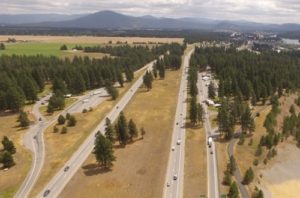The key role birds, bees, and insects play in agricultural propagation is typically celebrated once a year during events such as Pollinator Week. But for many state departments of transportation, support for such “pollinators” is becoming a year-round endeavor.
Take Idaho, for one. Idaho has more than 11.8 million acres in agricultural production and many of the state’s leading crops rely on insect pollination. For that reason, the Idaho Transportation Department (ITD) is actively engaged in supporting ants, butterflies, beetles, and other wildlife responsible for helping pollinate flowering plants.

For starters, the ITD follows the Idaho Pollinator Protection Plan – recently published by the Idaho State Department of Agriculture – and partners with both it and the Idaho Department of Fish and Wildlife to put that plan into action.
One example of the ITD’s use of the plan’s guidelines can be found at the Interstate 84 Westbound Bliss Rest Area. A partnership between ITD, the Bureau of Land Management, the U.S. Fish and Wildlife Service, and Native Roots LLC resulted in the creation of a new “pollinator garden” located on the grounds of that rest area grounds.
Cathy Ford, ITD’s roadside vegetation coordinator and program manager, explained that native flowering plants – such as the cordroot beardtongue and the firecracker penstemon – were added to the garden along with native plants to fit the arid environment and provide pollinator habitat. “We hope to do another one on the eastbound side in the future,” she noted.
[Editor’s note: ITD is also a part of the Candidate Conservation Agreement with Assurances or CCAA for the Monarch Butterfly – a national agreement established in April and supported by the American Association of State Highway and Transportation Officials that encourages transportation and energy firms to voluntarily participate in Monarch Butterfly conservation.]
In addition to the Bliss Rest Area, ITD has several other ongoing projects to promote pollination wellness. ITD’s District 5 is working to install pollinator plantings around its office in Pocatello, which will include small-stature flowering shrubs and perennial flowers as well as some milkweed plants – the only food source for Monarch caterpillars – salvaged in April from a state irrigation ditch construction project. The focus at the District Office is to provide blooming plants from early spring through fall to best support pollinators, Ford noted.
Pollination “wellness” efforts also impact state DOT duties such as roadside and right-of-way moving practices. The Illinois Department of Transportation for one now uses “revised” mowing practices aimed at creating and maintaining habitat for pollinators, including the monarch butterfly. Last year, the Illinois DOT began following the Illinois Monarch Project Mowing Guidelines for Pollinators, establishing July 1 to August 15 as its “most extensive” roadside and highway right-of-way mowing period.
The agency said in a statement that by timing when mowing takes place and reducing the amount of land being mowed, the Illinois DOT is encouraging the growth of critical plant species, such as milkweed.
Back in Idaho, the ITD is also involved in the Operation Wildflower Program, where districts distribute native wildflowers to volunteer groups to seed in selected areas. Partnerships between ITD and Idaho Fish and Game led to the formation of “pollinator waystations,” created by seeding roadsides with native flowers and grasses. These efforts not only support more pollinators but also beautify Idaho’s roadways and reduce maintenance costs, Ford said.
“ITD uses a variety of native seed and pollinator plant species for re-vegetation activities on construction and maintenance projects around the state,” she added.
Photo credit: Idaho Transportation Department

